Archive for October, 2009
Colorado Insurers Weight In – Finally
Posted by Joshua Sharf in Economics, Health Care on October 20th, 2009
Possibly too late, Colorado insurers are finally pointing out some of the economic fallacies inherent in the propose federal takeover of health care. Unfortunately, the insurers don’t go far enough in their condemnation. Fortunately, their opponents are simply reflexively trying to demonize them, and in the process, saying some really stupid things.
First, the insurers:
At issue are what insurance companies consider absurdly low penalties for people who choose not to buy health insurance.
Their concern: People will buy insurance only when they desperately need it, such as after they’re diagnosed with cancer or heart disease.
Healthy people might choose to pay the penalty, now proposed at a few hundred dollars per year, because it is far less expensive than buying insurance.
This is is true as far as it goes, but it’s not clear that even universal coverage would alleviate this problem. Still, the insurance companies have put their finger on a problem: if you’re not actually required to buy insurance until you’re sick, then that’s when you will buy insurance.
Naturally, this has led to howls on indignation from those defending the President’s and Congress’s proposals:
“They are assuming that people would game the system,” said Denise de Percin, executive director of the Colorado Consumer Health Initiative.
“They are looking at the worst-case scenario. People aren’t stupid — they are not going to pay a penalty and get nothing,” de Percin said. (emphasis added -ed.)
Guaranteed issue is, in and of itself, only part of the problem. Colorado has, in effect, a government guaranteed issue for a high-risk pool. The reason that this is unacceptable to those pushing reform is that by lumping the high-risk (or, already-established-risk) patients together, it creates a pool whose premiums are higher. They therefore argue for the concurrent requirement of “community rating.” which in effect pools the entire community – usually the state – together into one large pool where everyone gets charged the same amount. The various Democratic bills all contain some sort of community rating proposal as well.
In fact, we’ve already run this experiment in several states. The result is universally higher premiums, and it’s not hard to see why. Because now, as a healthy, premium-paying insured, I also need to cover the actual costs of people who waited until the diagnosis to get insurance, and the estimated costs of new people likely to enter the system who haven’t been diagnosed yet.
De Percin is right; people aren’t stupid, which is why they’d rather pay a penalty than pay for insurance they don’t need. They could take the difference and save it, invest it, or buy catastrophic insurance, which doesn’t qualify as “insurance” under the plan, even though it comes much closer to the ideal of insurance. The penalty is just the cost of participating in the system in the way they think is most to their benefit. The insurance companies’ argument, that the penalty for not playing has to be bigger than the overall cost of playing – is perfectly sound.
There are two fundamental flaws with how we think of insurance, and the way they interact is complicated by the fact that they’re mutually incompatible: 1) we think we’re spending other people’s money, and 2) we think of insurance as pre-paid medical expenses. One of these is a shell game, and the other is counter to the notion of insurance. The “guaranteed-issue/community-rating” combination just plays to the worst of both assumptions.
Billions Short on Bureaucrats’ Wish List
Posted by Joshua Sharf in Budget, Colorado Politics on October 16th, 2009
That’s really how this morning’s Denver Post story should read:
The state would need an additional $8.5 billion per year in revenue to provide the level of services Coloradans want, a commission looking into the state’s long-term budget problems was told Thursday. That’s bigger than the $7.5 billion general fund, the state’s largest pot of money that funds most operating needs. Even to reach a “middle” level of services, the state would need an additional $2 billion a year, members of the Long-Term Fiscal Stability Commission were told.
So how to we know this? Who measure what Colorado really wants? Why, the department heads:
Those estimates come from legislative analysts who added up the amounts that officials from various state agencies said would be needed to reach the level of services that Coloradans want. (emphasis added -ed)
How the department heads determined “what Coloradoans want” is left the the readers’ imagination, but I’m guessing that the result more closely tracks what Colorado’s department heads want. I’m also guessing that not too many of them came back with a report saying that they really could manage with less. Whenever you ask a government department head how much he needs, the answer is, inevitably, “more.”
Note, by the way, that the $2 billion is still considerably larger than the decrease in tax revenue the government has had to deal with in this recession, and that a $8.5 billion increase would essentially double the size of state government. That size, by the way, has been relatively static at about 8% of state GDP for over a decade.
Democrats on the committee naturally took up the legislative committee’s description of this wish list as, “what the people think they want.”
Perhaps most disgraceful of all was Rollie Heath’s suggestion to circumvent little things like democracy:
More controversial was his proposal to ask voters in 2010 to allow a 23-member commission appointed by the Legislature, governor and Colorado Supreme Court to examine constitutional spending requirements and limitations like the Taxpayer’s Bill of Rights and Amendment 23. That group would have the power then to refer any proposed changes to the 2012 ballot without needing to get legislative approval or collect voter signatures and would be exempt from a state law requiring all ballot measures be limited to just a single subject, Heath proposed.
This is bizarre on many levels, not least the complete abdication of legislative responsibility, as well as an admission of the futility and uselessness of the commission that Heath is chairing at the moment. The inclusion of representatives from the Supreme Court on a policy-making body would, I suppose, just formalize an inappropriate role they’ve increasingly taken on in recent years.
So here you have it. Even as your salaries and job options are shrinking, the legislative Democrats are trying to find new ways to raise your taxes, to pay for their wish list, without having to take responsibility for it.
$691,000 Per Job
Posted by Joshua Sharf in Colorado Politics, Economics on October 16th, 2009
Although the Denver Post doesn’t do the math, that’s how much each job created in Colorado has cost the Federal Government, er, you.
$583 million in Recovery Act funds have flowed to 96 different companies, individuals and other entities such as housing authorities.
Though Colorado was ranked as the top job creator among states — given TeleTech’s hiring of 4,231 people to staff a series of call centers — only 379 of those employees worked in Englewood. The rest were scattered throughout the country, such as in London, Ky., and Ocala, Fla.
So, it’s not 4695 jobs, it’s 843 jobs here in Colorado, and that’s if we include the 379 that have since gone away from TeleTech.
$583 million spent, 843 jobs. Quite a deal you made for us there, Rep. DeGette and Sen. Bennet.
Why We Miss the Rocky
Posted by Joshua Sharf in Media Bias on October 16th, 2009
CNN and the Detroit Free Press remind me of why we miss the Rocky Mountain News.
Years ago, the News had a foreign affairs editor named Holger Jensen. Jensen was relentlessly anti-Israel, reliably making excuses for her attackers, and faulting Israel for defending herself. His fact-checking was always a little suspect, but in April 2002, Jensen went too far. He reprinted offensive excerpts from an Amos Oz interview purported to be with Ariel Sharon. In fact, the interview was not with then-Prime Minister Sharon, but with another soldier.
This was, you remember, mere weeks after the murderous Passover Bombing in Netanya. Israel’s response, which was drawing howls of indignation, and Jensen probably thought the timing was right.
The timing couldn’t have been worse. The Rocky had finally had enough, and Jensen was forced to retire.
The *best* respose so far to the Limbaugh Quote Fabrications has been a sort of looking-down-at-one’s-feet-while-poking-the-ground-with-one’s-toe that you’d get from a kindergartener. More typical has been a pro forma, “sorry,” while skipping away to the next maladventure, typical of a sixth grader.
Which is what you get when the Adult Supervision has left the room.
California vs. Texas – Exports
Posted by Joshua Sharf in Economics on October 12th, 2009
We all know that as California has failed, Texas has prospered. We all know that jobs and people are fleeing Paradise for Hell. We all know that it costs about 3 times as much to rent a truck from California as to make the return trip from Texas. What I haven’t seen is an analysis of the role that exports have played in this reversal.
In fact, Texas exports more that California does, and has since 2002:
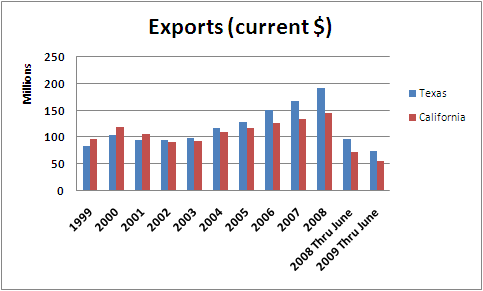
Both states have suffered from the global recession, but California on a percentage basis has suffered more, losing roughly 1/3 of its exports, while Texas has lost only about 25% of its exports year-to-date. The numbers will be at year’s end, but Texas won’t be nearly as bad off.
Some of this is accountable to a general growth in exports over the last decade, but to the extent that’s true, California hasn’t benefitted, and Texas has outperformed the rest of the country, even as its exports have outperformed the rest of its economy, while California’s have languished (watch out for the color switch):
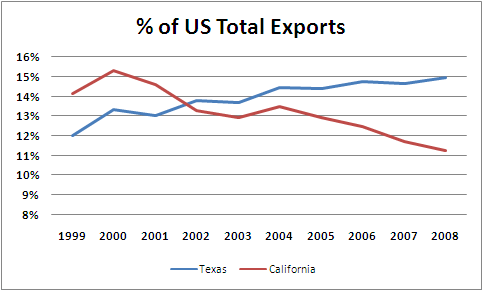
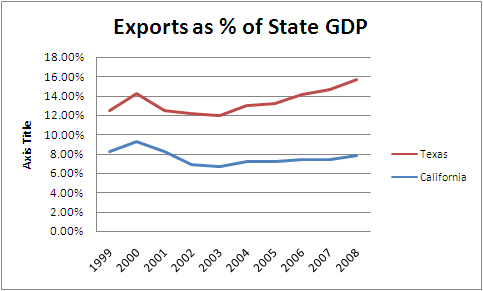
Now technically, tourism is an export, but this isn’t a result of Mexican day-visitors coming across the border for shopping and Six Flags. The biggest contributors to Texas’s export growth have been Chemical Manufactures, Petroleum and Coal Products (yes, exporting oil products), Machinery manufactures, and Computers and Electronics. Petro exports had multiplied 7x from 1999 to 2007, even before the 2008 run-up in oil prices. Over the same period, Chemical exports tripled, and Machinery exports grew by 150%.
In the meantime, California’s Silicon Valley hardware exports suffered after the dot-com bubble burst in 2000, and have never recovered. In 1999, over 50% of California’s exports were Computers & Electronics. They now constitute just under 30%, down 16% in dollar terms from 1999, and almost 1/3 from their 2000 peak. The diversification in California’s exports should be a benefit, and may yet be. But the exports are going to have to actually grow and be competitive for the state to benefit.
Here’s the comparison between a couple of sectors of the two states’ exports over the period in questions:
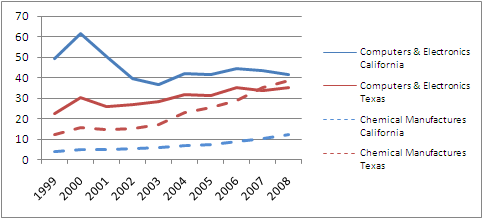
All of this might be moot if it were just a matter of underselling the competition and running sweatshops. But in fact, Texas’s GDP has been growing, and over the last decade, its per capita CDP has caught up with California:

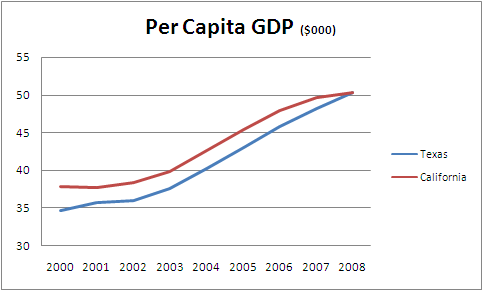
All these numbers, by the way, are from the Census Bureau, which also operates an fantastic site for cruising a state’s export numbers.
Now before we go all gaga about this, and show how this proves that under current conditions, Americans can compete with anyone overseas, these numbers don’t show how much of Texas’s exports come from cannibalizing from the rest of the country. And a State Business Tax Climate ranked #11, compared with California’s #48, would indicate that some of these exporting businesses have relocated. Still, there’s no doubt that exports are a major – and under-reported, factor in Texas’s move past California as an economic engine.
Chinese Futures Markets
Posted by Joshua Sharf in China, Economics on October 12th, 2009
The Wall Street Journal reports this morning that China is seeking to upgrade and expand its commodities futures markets in order to influence commodities prices, arguing that on-shore exchanges will help increase market efficiencies:
Government officials say the country is positioning its futures markets to be major players in setting world prices for metal, energy and farm commodities. By letting the world know how much its companies and investors think goods are worth, China hopes to be less at the mercy of markets elsewhere.
But what’s more likely is that China wants to lure traders on shore in order to use its national bargaining power to obtain more favorable prices. It’s not until the very end that the reason to be suspicious is mentioned:
International futures-market benchmarking has been slow to shift to China from long-established exchanges like the New York and Chicago venues. Despite China’s huge volumes, its futures markets allow foreigners limited access. By contrast, the London Metal Exchange says 95% of its business emanates from overseas.
General Motors Co., Ford Motor Co. and Tyson Foods Inc. are some of the companies that use futures in the U.S. to protect themselves from volatility in commodity prices. Despite expanding production in China, and being technically eligible to hedge on China’s exchanges, all three say they haven’t used its futures markets.
Instead, the big footprints in China’s futures markets belong to state-owned groups, primarily commodity trader Cofco Corp. and Beijing’s secretive stockpiling agent, the State Bureau of Material Reserve. That makes the government both player and policy maker. (emphasis added)
Right. Which means that China, which has a classic mercantilist approach to economics – seeking to use national power for the benefit of its industries – will be able to set the trading rules to its own benefit. China has been practicing what can only be described as a neocolonialist policy all over the world in pursuit of cheap commodities. It has been, as the article notes, deploying its navy to protect shipping routes, discovering the colonial truth that far from trade following the flag, the flag necessarily follows trade.
In fact, as the first paragraph in the above quote points out, these are world markets, and there’s no reason that China can’t trade openly in accounts no matter where they’re located. In fact, the three companies mentioned in the second paragraph manufacture in China, and hedge on the US markets. One likely advantage of trading with a home field advantage is that its government players won’t have to reveal their moves the way they will in more tightly regulated London and New York.
One expects that eventually, with the trading markets established, the right to continue doing business on favorable terms will come with increasing conditions, one of which may be that a company has the hedge its local commodities exposure with Chinese futures. Given the compromises that companies make to do business in China in the first place, including rarely owning 50% of their own subsidiaries and seemingly deferring profits until the late 22nd Century, hedging on local markets will just be another in a long line.
The eventual effect of such a policy, if successful, would be to drive up commodity prices for the rest of the world while keeping them low for China, hampering competition, shutting down industries in competing countries, such as the US, while allowing China’s exports and domestic markets to develop. Such a strategy only works, of course, if there’s no comparably-sized competitor, which argues for countermeasures by the US, combined with more open trade with India (which has protectionist problems of its own).
In the long run, of course, such a strategy is doomed. The imbalances that it creates will inevitably provoke a reaction from the rest of the world, such as what Japan saw in the 1980s. Moreover, it’s not sustainable forever. Exports demand markets. China is aging, and is an unlikely autarky, which is why it’s seeking to use its political (and eventually militaryp) power to secure resources. But the long run can be very long, indeed, and the damage that China can inflict on us in pursuit of this policy can be great. Which, of course, may also be all part of the plan.
Call This the Paris Hilton Peace Prize
Posted by Joshua Sharf in Uncategorized on October 9th, 2009
Look, there are a half-dozen obvious ways of interpreting what the Swedes were thinking
This was the left-of-liberal left congratulating itself. This was the left-of-liberal left honoring the President who will lead the US into retirement. This committee was trying to encourage him in a Young-World-Leader-Most-Likely-to-Succeed sort of way. The committee really believed what it said about “outreach.” The committee was meeting in Malmo. The Scandanavians were sorry about how the IOC treated him the last time he was over there.
What’s clear is that this award isn’t for actually having done anything.
There was a time when Time Magazine’s “Man of the Year” was eagerly awaited. Right up until they named. “The Computer” the Person of the Year, never mind the actual, you know, people who had invented, marketed, and exploited it.
This is a continuation, almost a logical conclusion, of the phenomenon of being famous for being famous that Daniel Boorstin wrote about in The Image all those years ago. It’s a world where celebrity is based on prior celebrity, rather than on concrete achievement or accomplishment.
In a way, it’s a surprise that it took this long. We’ve had science-by-press-conference, wherein little actual peer-reviewed science is done, but plenty of politics is practiced. And the Middle East has long been a bastion of “peace by press conference,” where meeting and negotiations are announced, and everyone sits around reading the coffee grounds to see what they mean. (Hint: they still hate us.)
The worst thing about this prize is that it’s not likely to encourage actual peace-making, it’s just going to encourage all that’s worst about the Cult of Obama, and its practitioner-in-chief. Winning what used to be the world’s greatest secular moral award is likely to reinforce Obama’s sense of his own magnificence. Any hopes – and they were slim – that he might have learned something from last week’s Denmark Debacle are dashed. The man could probably walk away from the Infinite Perspective Vortex unscathed at this point.
If this were just the Nobel Equivalent of 4th grade social promotion, it might not be so bad. That’s what it’s been in the past. You collect your prize, you go home to Georgia or Ramallah and hang it on a wall. (In Al Gore’s case, you find some way to electrify it so it lights up the night sky.) But this is to a sitting President, with real duties to discharge. Failures have real-world consequences for the US and its citizens, and nurturing Obamanian Infaalability isn’t likely to help him avoid them.
If the Nobel Committee had really wanted to do what all of its apologists suggest – encourage peace prospectively – they could have given it to the Iranian opposition, who are busily dying in the streets for their liberty and their country. Hanging the mullahs by their turbans in the public square and establishing a decent secular regime there would do more to promote peace at this point than just about anything.
Of Reports Serious and Unserious
Posted by Joshua Sharf in Israel on October 9th, 2009
The Goldstone Report, the UN’s attempt to indict Israel for defending itself, has failed on so many levels that only an organization as twisted as the UN could continue to hold it out as anything other than propaganda. Right now, the PA sees more advantage in using it to attack Hamas, but that may not last much longer. Daled Amos has done yeoman work comparing the report’s absolution of Hamas with contemporaneous news accounts to the contrary. At the same time, Max Boot notes the report’s bizarre application of standards that would make national self-defense impossible for Israel were they actually followed. Gerald Steinberg, in his laundry list of biases, both through active hostility and laziness worthy of the MSM, comes close the uncovering the problem:
Mr. Goldstone’s professional qualifications are anchored in international law, but if anything, this report highlights the absurdity of a vocabulary and framework that are anachronistic. Applying classical concepts and terms to terror and asymmetric urban warfare, in which the entire population is a massive human shield and hospitals are used as command headquarters, as in the case of Gaza, is ridiculous.
The report, according to Mr. Steinberg, fails because it is little more than a collection of category errors, applying what amount to civilian law-enforcement standards to a matter of national self-defense. If the consequences of international law producing such a document weren’t so dire, the report would be deeply unserious.
For a serious look at the Operation Cast Lead, look to the serious people at Azure, a journal dedicated to revitalizing the intellectual life of religious Zionism. It has published a detailed analysis of Israeli actions during the operation, according to Just War Theory. Asa Kasher, the author of the article, co-founder of the Journal of Military Ethics, and a professor emeritus at Tel Aviv University. Kasher is not seeking to address every action by every soldier, but instead attempts to place the entire operation, its goals, means, and methods as laid out by the Israeli military, in a philosophical framework. If the Goldstone report attempts to convict the operation by virtue of often-questionable specifics, Kasher makes the case for the overall justness of the war, and the values by which it was fought.
For the time being, then, we should focus on the first stage of investigation mentioned above and restrict ourselves to examining the moral, ethical, and legal requirements to which decisionmakers and participants in military actions are bound. These requirements predate and are not dependant on the specific facts of Operation Cast Lead. However, though we are not in a position to provide a comprehensive answer to all the questions raised about what took place in the Gaza Strip during January 2009, the data collected so far permits us to conclude that a significant part of the criticism directed at Israel and the IDF during and after the operation was, to say the least, based on flimsy evidence.
Just War Theory lays out eight principles forming the “basis of the standard moral discussion of war.”
- A state must have a compelling justification for taking military action against a state, entity, organization, or individuals outside its borders
- The use of military force is, therefore, justified only if all other alternatives have been exhausted. In just war theory, this is known as the principle of last resort
- The principle of right intention demands that a state not only wage war in a just cause, but that all of its intentions, on every level, be equally justifiable
- The probability of success principle prohibits taking military action—which inevitably involves death, suffering, and destruction—if it is certain to fail
- The principle of macro-proportionality: The positive results of the operation should be measured in terms of the protection it has provided to the state and its citizens at the conclusion of the military campaign and its aftermath. The negative results should be measured in terms of the death, suffering, and destruction inflicted on the other side
- The principle of micro-proportionality: in regards to specific military actions that endanger harmless enemy non-combatants
- The most important aspect of the relationship between a state and its citizens is the obligation of self-defense. This is one of the highest duties of a properly functioning democratic state
- The principle of distinction, one of the most important when fighting an enemy who both attacks your civilians and hides behind his own:
The principle of distinction presents the combatant with three different standards of conduct to guide him in any military action: (a) a standard he should follow when facing a group comprising enemy combatants and no one else; (b) a standard he should follow when facing a group of enemy non-combatants who are not participating in the fighting and are not in proximity to enemy combatants; (c) a standard he should follow when facing a mixed group of combatants and non-combatants.
Kasher then goes on to examine the Israeli decision to go to war, and its conduct therein, in light of these principles. Read the whole thing.
If international law seems remote from these considerations, it is a failing of international law, not the ethical framework. Paul Robinson, of the University of Pennsylvania, gets it right:
Because international law has no enforcement mechanism, it is almost wholly dependent upon moral authority to gain compliance. Yet the repuration international law will increasingly earn from its rules on the use of defensive force is one of moral deafness.
Legislative Council Predicts…
Posted by Joshua Sharf in Budget, Colorado Politics on October 2nd, 2009
Every three months, the Legislative Council comes out with a report saying that the state budget is in even worse shape than we thought it was. And with every report, we’re told how Legislative Council keeps missing because of the unprecedented speed and size of the change. Fortunately, we can go back and see how well the LC has done in the past. I don’t think I’ve seen the data presented this way before, but apologies if someone has done so.
The LC makes predictions up to 5 years out (although their latest report only goes through the FY2011-12), so here’s a rolling graph of the predictions of General Fund revenue (in $M) since March of 2000. The numbers are not net of TABOR, meaning they do not account for the TABOR limits, so it’s purely an estimate of gross revenues. The gaps represent reports that the LC has not posted on their site:
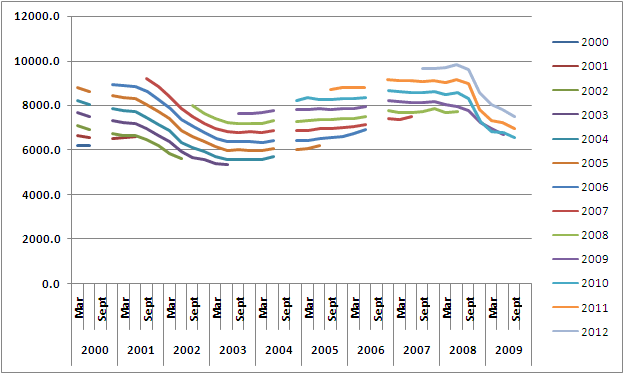
So the first thing you notice is that, no matter what the current conditions, LC almost always predicts a rising income curve even though that generally doesn’t reliably happen. In fact, it’s not just a rising income curve, it’s a almost always a constantly rising income curve. It looks like those pictures you used to draw in 1st grade, taking all the different-colored crayons or chalk or markers and running them along the page in unison. The current year estimates represent reality, but after that, LC assumes more robust growth rate that declines slightly towards Year 5.
Why? To put it simply, they have no idea what the actual economic growth rate is going to be, so they fake it. And it’s responsible for their consistent over-statement of future revenues throughout the decade.
The other thing you notice is that the recession of 2001-2002 took a pretty hefty toll on state revenues, and that it caught the LC completely by surprise. If it hadn’t, they wouldn’t have had to adjust their predictions so radically. In fact, the decline in dollar amounts is pretty close to the decline in the 2007-2009 recession, although the falloff wasn’t as fast.
Another way of looking at this is on a percentage basis of the eventual revenue:
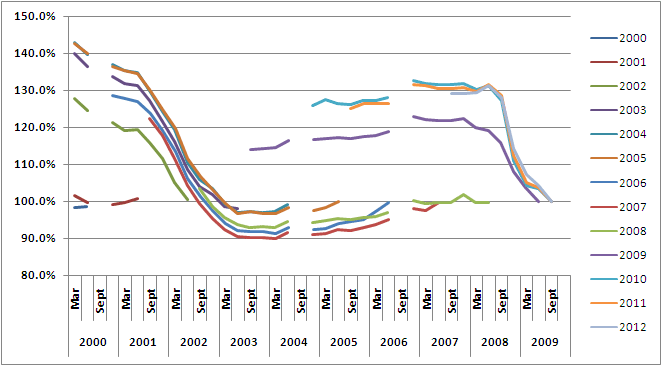
On this basis, the 2001 recession was every bit as bad – if not worse – for state revenues as the current one has been so far, it just took longer for the forecasts to fall. Remember, it was this recession, and the resulting drop in state revenues, that convinced the public to pass Referendum C. More on that in a moment.
The pattern of overestimating revenues and then mildly over-correcting is even more obvious if you synchronize the estimates at their endpoints. (The budget year ends in June, but the preliminary revenue numbers aren’t available until September, so 6 year projections stretch over 7 calendar years.)
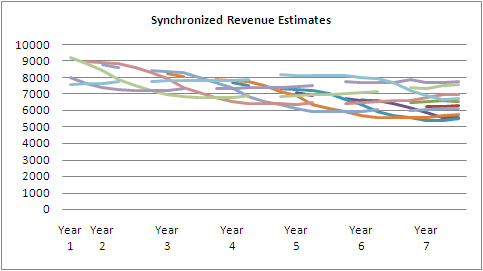
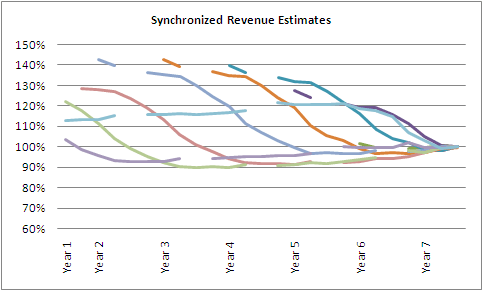
Some of this might be understandable if the secular trends were of declining revenues, but it hasn’t been:
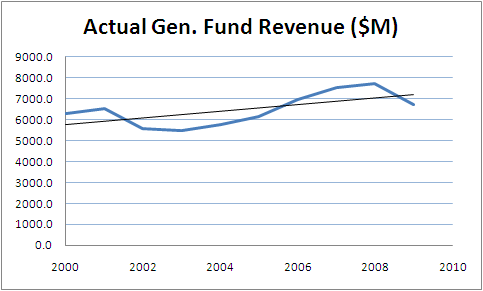
Which means that even in a era when the general trend has been upwards, the Legislative Council has overwhelmingly overestimated upcoming revenue. Again, this is almost certainly a result of using a plug-in number for economic growth during the out years. This is standard practice – we used to do something similar all the time when modeling companies’ top lines – but we weren’t responsible for their budgets. It clearly shows the dangers of actually relying on these predictions for budgeting and for policy-making. Certainly it contributed to the over-confidence that led to Amendment 23, and the same overconfidence that has led the legislature to spend every last non-existent dime of Referendum C monies.
Now about that. Proponents of TABOR, among whom I count myself, have often argued that TABOR’s limitations helped limit the damage from the 2001-2002 recession. Is this true? Well, probably, but it didn’t prevent the damage altogether, otherwise there would have been no cry for Referendum C. Nevertheless, by looking at the revenue estimates for one year, and comparing them with the TABOR-revenue estimates, we can see that the raw numbers varied much more than the TABOR-adjusted estimates. We use 2005 because it’s one year for which we have a full
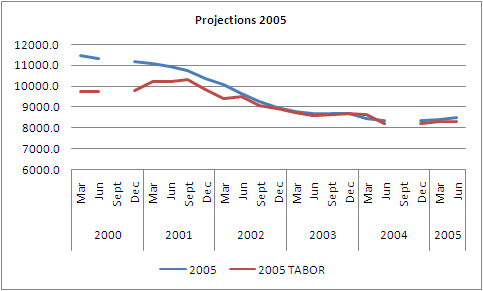
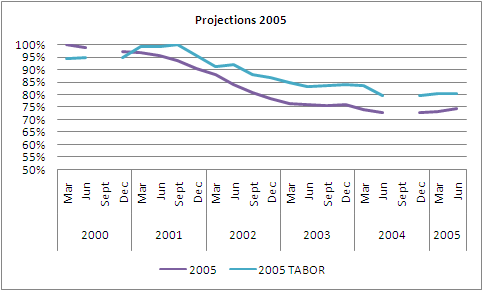
As you can seen, the raw revenue estimates fell to as low as 72% of the original estimate, finishing up at 75%, while the revenues including TABOR refunds stabilized at 80% of the original. Someone doing budgeting even a year out would have had to cut an additional 8% from programs had they used the raw numbers, as we do under Referendum C, compared to someone who had limited himself to TABOR-adjusted revenues. This isn’t exactly Armageddon, but it ain’t chicken feed, either. Given the howls of pain that come from even modest cuts in government programs, the 8% surely must be counted significant.
None of this is intended to beat up of Legislative Council. They’re being asked to do an impossible job, and appear to be doing it much better and with more integrity than the governor’s office is. But to repeat – it indicated the foolishness of relying on long-term estimates for actual budgeting, and makes a case for the sort of conservatism that TABOR forces upon the legislature.



